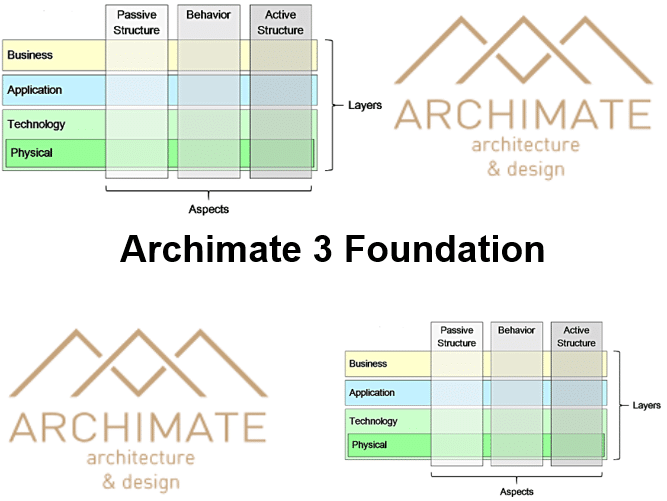-
Learning by doing
-
Trainers with practical experience
-
Classroom training
-
Detailed course material
-
Clear content description
-
Tailormade content possible
-
Training that proceeds
-
Small groups
In the course ArchiMate 3 Foundation participants receive a strong foundation in architectural modeling using the ArchiMate language. The course includes practical exercises, case studies and exam preparation to enhance participants proficiency in architectural modeling.
The course Archimate 3 Foundation starts with an overview of the importance of Enterprise Architecture in organizations. Discussed are standards in the field of EA Architecture Modeling and the role of Archimate and tools therein.
Attention is paid to the hierarchical structure of Archimate where a model is considered as a collection of elements and relationships. The distinction between behavior, structural, motivation and composite elements is covered as well.
Subsequently Business Modeling in Archimate is treated, where the operational organization of a company is described in a technology-independent manner. This covers Business Functions, Processes, Services and Objects, as well as Interactions and Events.
Application Architecture is also discussed, using a subset of the ArchiMate elements such as Application Component, Application Service and Application Interface. Also covered is how the Layered View makes the context of an application visible.
Modeling the Technology Architecture with Technology Layer elements such as Technology Services, Events and Interfaces is also treated. Both Active and Passive Structure elements play a role in this.
Also part of the course Archimate 3 Foundation is Strategy Modeling in the Strategy Layer. The elements Resource, Capability and Course of Action serve herein to model the strategic goals of the company,
Then implementation migration planning is covered with the viewpoint of relating applications and projects to the parts of the architecture that they implement.
Finally the course discusses how you can certify for Archimate 3 and what the exam requirements are. Tips and tricks for passing the exam will also be treated.
The course Archimate 3 Foundation is intended for enterprise architects who want to use the Archimate 3 language when designing an Enterprise Architecture.
General knowledge of Enterprise Architecture and modeling if EA is desirable to participate in this course.
The Archimate 3 Foundation course has a hands-on character. Theory based on demos is interchanged with practical assignments for creating Enterprise Architecture models in Sparx Systems Enterprise Architect.
After successfully completing the course, participants will receive a certificate of participation in the course Archimate 3 Foundation.

Module 1 : Intro EA |
Module 2 : ArchiMate Concepts |
Module 3 : Business Modeling |
|
What is Enterprise Architecture Importance of EA in Organizations EA Frameworks and Standards EA in Decision-Making Introduction to ArchiMate Evolution of ArchiMate ArchiMate's Role in EA ArchiMate Certification ArchiMate Modeling Tools Elements and Notation Relationships in ArchiMate UML Modeling Standard Sparx Enterprise Architect |
ArchiMate Layers Business Layer Application Layer Technology Layer ArchiMate Aspects Active Structure Passive Structure Data and Service Concepts Actor and Role Concepts Business Process Concepts Function Concepts Technology Service Relationships and Connectors |
Business Layer Overview Actors and Roles Business Collaboration Business Interface Business Function Business Process Interactions and Events Business Services Business Objects Business Process Modeling Services and Relationships Business Capabilities Archimate Meta Model |
Module 4 : Application Modeling |
Module 5 : Technology Modeling |
Module 6 : Strategy Modeling |
|
Application Layer Overview Application Components Application Collaborations Interface and Functions Application Services Application Processes Interactions and Events Data Objects Application Artifacts Services and Relationships Integration and Interfaces |
Technology Layer Overview Diagram Types Technology Collaborations Interfaces and Functions Service and Processes Technology Interactions Technology Object Technology Artifacts Services and Relationships Infrastructure Considerations Deployment Considerations |
Motivation and Strategy Concepts Stakeholders and Concerns Sequence Diagrams Goals, Drivers, and Objectives Assessment and Gap Analysis Principles and Requirements Motivation Elements and Notation Strategy Mapping and Alignment Strategy Modeling Best Practices Strategic Planning and Execution Legends and Grouping |
Module 7 : Implementation Planning |
Module 8 : ArchiMate in Practice |
Module 9 : Archimate Certification |
|
Implementation and Migration Planning Implementations Project and Roadmap Views Work Packages and Dependencies Implementation Elements Transition Planning Transition Execution Gap Analysis Impact Assessment Agile and DevOps in Architecture |
ArchiMate in Real-World Projects Industry-specific Use Cases ArchiMate Modeling Patterns Tips for Effective Modeling Collaboration and Version Control Reporting and Documentation ArchiMate Tools and Ecosystem ArchiMate and Other EA Frameworks Certification Preparation ArchiMate Future Trends |
Certification Overview Abstracting Elements EAI Patterns Information Resources Views and Maps Aspect Orientation ArchiMate Exam Objectives Exam Preparation Tips Sample Questions and Mock Exams Test-Taking Strategies |
